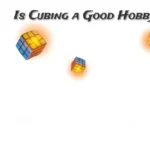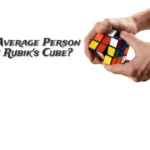Rubik’s Cube, the iconic 3D puzzle, has baffled and intrigued millions of people around the world since its invention. Its deceptively simple design hides a complex interior consisting of small cubes with multiple colored faces that can be manipulated to create an array of scrambled patterns. For most, solving the Rubik’s Cube remains a daunting challenge that requires dedication, practice, and a deep understanding of specific algorithms. However, a lingering question captures the imagination of many: Has anyone ever solved the Rubik’s Cube without learning a single algorithm?
The traditional approach to solving the Rubik’s Cube involves mastering a series of algorithms, which are essentially sequences of moves designed to manipulate the cube’s pieces into the desired position. Speedcubers, who can solve the cube in record-breaking times, often spend months or even years perfecting their skills. They memorize algorithms, practice countless times, and develop an intuitive understanding of the cube’s mechanics. But is there another way? Can someone simply pick up a Rubik’s Cube and, through sheer intuition or luck, solve it without any prior knowledge or practice?
This article explores the idea of solving a Rubik’s Cube without learning.
The Traditional Approach
- The traditional approach to solving the Rubik’s Cube is well-documented and involves a series of sequential steps. Cubers learn various algorithms that address specific situations or patterns on the cube. These algorithms may be as simple as rotating a single face or as complex as a series of moves that require precision and planning. Speedcubers have managed to solve the cube in record times using these algorithms, but this level of mastery demands extensive practice and dedication.
- The process begins with solving one face of the cube, typically the white face, and then systematically solving the remaining layers one by one. As layers are solved, cubers learn to adapt to new challenges that arise, using algorithms designed for those specific scenarios. The process is highly methodical, requiring a deep understanding of cube mechanics and a substantial time investment. The vast majority of people who attempt to solve the Rubik’s Cube using this approach find it challenging and often give up before reaching the solution.
The Unconventional Approach
- Contrary to the conventional approach, there are tales of individuals who have claimed to solve the Rubik’s Cube without any prior knowledge or learning. These accounts often feature a combination of luck, intuition, and experimentation. The unconventional approach captures the imagination of those who wish to defy the traditional path to success.
- At its core, the unconventional approach involves looking at the Rubik’s Cube as a puzzle and experimenting with different moves without relying on algorithms. The human mind is naturally inclined to recognize patterns, and some individuals believe that, through sheer luck or an innate sense of spatial awareness, they can manipulate the cube’s pieces to arrive at a solved state. These unconventional solvers often rely on trial and error, but there is more to it than simple chance.
The Human Mind and Pattern Recognition
- The human mind’s ability to recognize and create patterns is an essential aspect. From deciphering intricate mosaics to solving complex problems, pattern recognition plays a crucial role in our cognitive abilities. When it comes to the Rubik’s Cube, the brain naturally seeks out patterns and logical sequences, even if we don’t consciously understand the mechanics of the cube.
- Intuitive solvers often rely on their brain’s inherent pattern recognition abilities. They manipulate the cube’s pieces, experimenting with various combinations of moves until they observe promising patterns or configurations. The brain processes this information, and over time, an intuitive solver may find a way to align the cube’s colors into a solved state.
- This reliance on pattern recognition mirrors how we learn and adapt to various life challenges. While traditional solving methods involve a structured learning process, intuitive solving taps into the brain’s problem-solving capabilities, and this approach can yield surprising results.
Has Anyone Ever Solved Rubik’s Cube Without Learning?
To better understand the unconventional approach, let’s explore a few case studies of individuals who have claimed to solve the Rubik’s Cube without learning algorithms.
Beginner’s Luck or Intuition?
- One of the most common themes among intuitive solvers is what’s often referred to as “beginner’s luck.” In these cases, someone who has never attempted to solve a Rubik’s Cube picks one up and, through a series of random moves or experimentation, manages to complete it. This phenomenon is particularly common with children, whose brains are highly adaptable and tend to excel at pattern recognition.
- The question here is whether this is truly luck or an innate ability to recognize patterns. Children often excel at solving the cube intuitively because they are unburdened by the preconceived notion that the cube is complex and challenging. They approach it with a sense of curiosity and a willingness to experiment, ultimately leading to success.
The “Natural” Solvers
- There are individuals who, despite having never studied algorithms or practiced solving the Rubik’s Cube, manage to achieve a solved state through sheer intuition and experimentation. They often describe the experience as if something “clicked,” and suddenly, they found themselves completing the puzzle without any formal training.
- These cases are particularly intriguing because they challenge the notion that algorithm-based learning is the only way to solve the Rubik’s Cube. They suggest that some people might have an innate talent for intuitive solving, which can be developed with practice and experience.
Conclusion of Case Studies
The case studies of intuitive solvers highlight the possibility of solving the Rubik’s Cube without learning the traditional algorithms. While these instances may be relatively rare and often met with skepticism, they underscore the human brain’s capacity for pattern recognition and problem-solving.
However, it’s essential to acknowledge that these cases are exceptional and do not negate the value of learning and mastering algorithms for solving the Rubik’s Cube efficiently. For the majority of people, the conventional approach remains the most practical and reliable path to success.
The Limits of Intuition
- Intuitive solving of the Rubik’s Cube, while fascinating, has its limits. Understanding the distinction between accidental solutions and intentional, repeatable solving is crucial. Accidental solutions may occur when someone randomly twists the cube’s faces until, by chance, the colors align perfectly. This is not the same as being able to consistently and intentionally solve the Rubik’s Cube without any prior knowledge or practice.
- The key to reliable, intuitive solving lies in developing a deep understanding of the cube’s mechanics, which can take time and experimentation. While some individuals may achieve an intuitive solution through luck or innate talent, it’s not guaranteed for everyone.
The Educational Value
- The Rubik’s Cube is not just a challenging puzzle; it also serves as a valuable educational tool. Learning to solve the cube through algorithms offers numerous benefits, such as improving spatial awareness, problem-solving skills, and patience. It can be a gateway to understanding complex concepts like group theory and combinatorics, which have practical applications in various fields.
- Additionally, learning to solve the Rubik’s Cube can be a rewarding experience, providing a sense of accomplishment and satisfaction. It’s a tangible demonstration of how perseverance and learning can lead to mastery, a valuable lesson that can be applied to other areas of life.
The Role of Algorithms
- Algorithms are the backbone of efficient Rubik’s Cube solving. They provide a structured and systematic approach to addressing the various patterns and challenges that can arise during the solving process. For those who wish to become proficient cubers, algorithms are an indispensable tool.
- Algorithm-based solving allows for precision and speed, making it possible to solve the cube consistently in a matter of seconds. Speedcubers often memorize dozens or even hundreds of algorithms to address specific scenarios quickly and effectively. The use of algorithms is a testament to the power of structured learning and practice in achieving mastery.
- However, it’s important to note that the use of algorithms should not discourage those who are interested in exploring intuitive solving. Algorithms are a valuable resource for those who want to excel in speedcubing, but they are not the only path to solving the Rubik’s Cube.
Conclusion
The age-old question of whether anyone can solve Rubik’s Cube without learning remains a captivating mystery. While the traditional approach of mastering algorithms and practicing extensively is the most reliable method for solving the cube, the unconventional approach of intuitive solving offers a glimpse into the fascinating capabilities of the human mind.
Intuitive solvers, guided by a natural aptitude for pattern recognition, have achieved remarkable results in their quest to solve the Rubik’s Cube without learning specific algorithms. While these cases may be relatively rare, they emphasize the boundless potential of the human brain to adapt, learn, and solve complex puzzles.
In the end, whether you choose to follow the traditional or unconventional path, the Rubik’s Cube continues to be a source of inspiration and fascination for generations to come.




